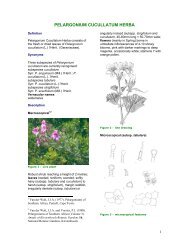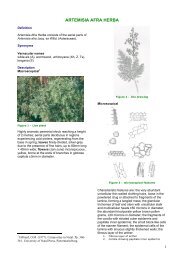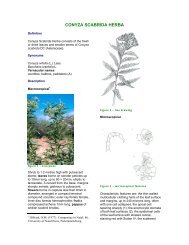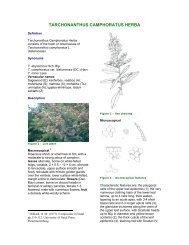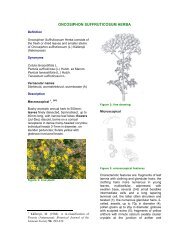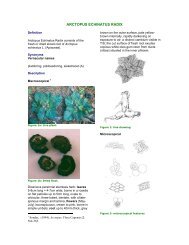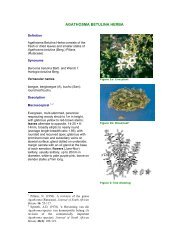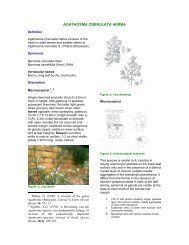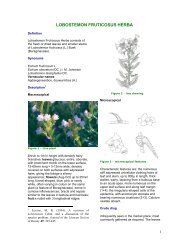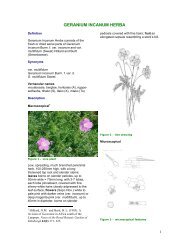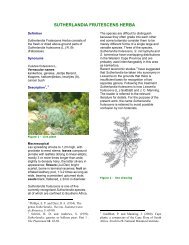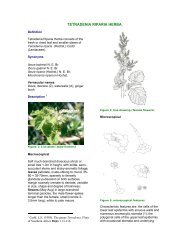CHIRONIA BACCIFERA HERBA - PlantZAfrica
CHIRONIA BACCIFERA HERBA - PlantZAfrica
CHIRONIA BACCIFERA HERBA - PlantZAfrica
You also want an ePaper? Increase the reach of your titles
YUMPU automatically turns print PDFs into web optimized ePapers that Google loves.
Definition<br />
Chironia Baccifera Herba consists of the<br />
fresh or dried aerial parts of Chironia<br />
baccifera L. (Gentianaceae).<br />
Synonyms<br />
Vernacular names<br />
aambeiebessie, bitterbos (A), Christmas<br />
berry<br />
Description<br />
Macroscopical 1<br />
Figure 1 –Live plant<br />
Figure 2 – line drawing<br />
1 Marais, W. and Verdoorn, I.C. (1963).<br />
Gentianaceae. Flora of Southern Africa 26: 171-<br />
243. Botanical Research Institute, Pretoria.<br />
<strong>CHIRONIA</strong> <strong>BACCIFERA</strong> <strong>HERBA</strong><br />
A neat rounded, much-branched perennial<br />
shrub to 70cm in height; leaves sessile,<br />
linear, soft to slightly succulent, 5-20mm<br />
long × 1-2.5mm wide, glabrous, bright<br />
green; flowers (Nov-Jan) solitary, terminal,<br />
deep pink, shortly tubular, up to 20mm in<br />
diameter with prominent yellow stamens<br />
inserted in the mouth of the tube; fruit (Jan-<br />
Mar) a glossy red berry, ± 7mm in diameter,<br />
with many black seeds.<br />
Microscopical<br />
Figure 3 – microscopical features<br />
Characteristic features are: the absence of<br />
hairs or calcium oxalate crystals of leaf and<br />
stem; the papillose cells of the leaf<br />
epidermis, with sinuous thickened and<br />
cuticularised walls (3), brick-shaped in<br />
sectional view (2); the crystalloid bodies of<br />
the epidermal and subepidermal layers (4);<br />
the large stomata of the leaf lamina, up to<br />
150µ in diameter (5).<br />
Crude drug<br />
Collected as needed or found in the<br />
marketplace as bundles of fresh or dried<br />
twigs, often with flowers and fruit; colour<br />
bright green-yellow, odour faint biteraromatic;<br />
texture soft when fresh.<br />
Geographical distribution<br />
1
Figure 4 – distribution map<br />
Widespread in the Western and Eastern<br />
Cape Provinces, from Namaqualand south<br />
to the Cape Peninsula and eastwards into<br />
KwaZulu-Natal, in dry sandy soil from sealevel<br />
to lower mountain slopes, often as an<br />
undershrub on dunes or at forest margins.<br />
Quality standards<br />
Identity tests<br />
Figure 5 – TLC plate.<br />
Thin layer chromatography on silica gel<br />
using as solvent a mixture of toluene:diethyl<br />
ether:1.75M acetic acid (1:1:1). Reference<br />
compound cineole (0,1% in chloroform).<br />
Method according to Appendix 2a. (figure 5)<br />
Rf values of major compounds: 0,28 (lilac);<br />
0,55 (royal blue); 0,94 (purple-mauve);<br />
cineole: 0,82 (blue-purple)<br />
HPLC on C18 column, method according to<br />
Appendix 2b.<br />
Major compounds:<br />
Figure 6 – HPLC spectrum<br />
Methanol extract: (figure 6)<br />
Retention times (mins): 12.23; 12.76; 21.05;<br />
22.96<br />
Ethanol (70%) soluble extractive value:<br />
not less than 33,0% (range: 33.63-<br />
41.60%)<br />
Purity tests<br />
Assay<br />
Not yet available<br />
Major chemical constituents<br />
Figure 7 – chemical constituents<br />
Microchemical tests in our laboratories<br />
indicated the presence of tannins and<br />
saponins but not of alkaloids nor of cardiac,<br />
cyanogenic or anthraquinone glycosides.<br />
The detection of tannin confirms the results<br />
2
of earlier studies 2 . The roots of this species<br />
have been shown to contain various<br />
secoiridoids: chironioside, eustomoside,<br />
gentiopicroside, sweroside and<br />
swertiamarin 3 . These are bitter principles,<br />
some of which occur in other members of<br />
Gentianaceae used in medicine e.g. the<br />
yellow gentian Gentiana lutea, which was at<br />
one time used as an appetite stimulant. It is<br />
not known whether secoiridoids are also<br />
present in the above-ground parts of this<br />
species. The triterpene saponin oleanolic<br />
acid has been reported from the leaves of<br />
this species 4 .<br />
Dosage forms<br />
Used mainly as an aqueous infusion, taken<br />
orally or applied externally. The leaves may<br />
be made into a poultice with fat, butter or oil.<br />
Medicinal uses<br />
Taken orally, an infusion of this herb is used<br />
as a purgative in the treatment of<br />
haemorrhoids and as a blood purifier in<br />
cases of recurrent boils, acne or veld sores.<br />
For the latter, a leaf poultice may also be<br />
applied to the affected area. Combined with<br />
Leonotis leonurus and Helichrysum<br />
petiolare, an infusion is said to be beneficial<br />
in the treatment of hypertension. Pappe (see<br />
GR 19 ) reported that Chironia baccifera was<br />
an effective remedy for syphilis.<br />
Pharmacology/bioactivity<br />
Little information is available regarding the<br />
pharmacology of this herb.<br />
Contraindications<br />
None reported<br />
2 Bate-Smith, E.C. (1972). Ellagitannin content<br />
of leaves of Geranium species. Phytochemistry<br />
11: 1755-1757.<br />
3 Wolfender, J-L, Hamburger, M., Hostettmann,<br />
K., Msonthi, J.D. and Mavi, S. (1993). Search<br />
for bitter principles in Chironia species by LC-<br />
MS and isolation of a new secoiridoid<br />
diglycoside from Chironia krebsiana. Journal of<br />
Natural Products 56(5): 682-689.<br />
4 Fourie, pers. Comm.. (1985).<br />
Adverse reactions<br />
Prolonged or excessive use of this herb are<br />
said to induce sleepiness and promote<br />
heavy perspiration.<br />
Precautions<br />
No special precautions<br />
Dosage<br />
Fresh herb (30g) is infused until cold with<br />
one litre of boiling water. If dried herb is<br />
used, 15g should be infused with one litre of<br />
boiling water.<br />
Internal use<br />
Adults: half a teacupful (90ml) three times<br />
daily.<br />
Children 6-12years: one quarter of a<br />
teacupful (45ml), diluted with boiled water,<br />
three times daily.<br />
External use<br />
The aqueous infusion, prepared as<br />
described above, may be applied with a<br />
clean cloth or cotton wool to sores, boils,<br />
acne, eczema or external haemorrhoids. For<br />
the same purpose, fresh herb, softened by<br />
heating with a little fresh cooking oil, may be<br />
applied as a paste on clean lint or cloth and<br />
held in place with a bandage.<br />
Copyright in this monograph resides with the authors, the South<br />
African National Biodiversity Institute, the South African Medical<br />
Research Council and the University of the Western Cape. It may<br />
not be reproduced in whole or in part without the written consent of<br />
the copyright holders.<br />
3



